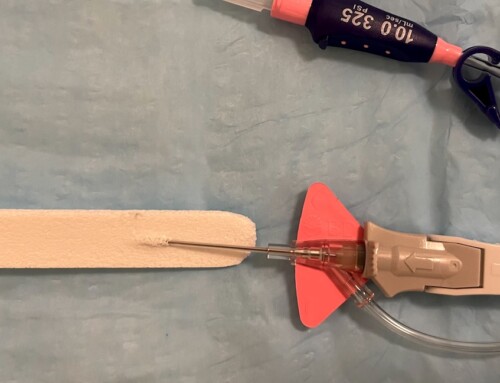Managing epistaxis is often challenging, time-consuming, and takes practice. Even under the best circumstances, epistaxis often results in return visits for rebleeding and poor outcomes. Rarely should you do “nothing” for adults who present to the ED with or following epistaxis. If it produced enough blood to seek care (even without hemodynamic compromise), epistaxis frequently recurs even if currently resolved. This is a less true in pediatric patients. A careful and comprehensive evaluation is essential in both populations, whether epistaxis is ongoing.
The following 11 pearls with a bonus tip should help you avoid common pitfalls, improve outcomes, and increase both patient and physician satisfaction:
- Wear proper protection during the procedure, including a face shield and gown. Nasal manipulation often causes patients to cough or sneeze, resulting in blood spray.
- Prepare your equipment in advance. Work with your nurses or techs to develop a policy where it is placed at the bedside when the patient is roomed. A bright, focused light is essential, ideally as a headlamp so both hands are free. This way, no assistant is needed. Cordless headlamps are easier to use but should be charged after each use.
- Although an elevated blood pressure or hypertension can worsen epistaxis, acute treatment is generally not required. Help your patient relax by establishing a calm presence, demonstrating confidence, and explaining your approach in advance. Done well, these actions are often sufficient to reduce their blood pressure.
- Have your patient slowly but firmly blow their nose to remove any clots that have formed, which not only will reduce or prevent medications from absorbing but will also interfere with visualization. After this, have your patient hold firm pressure with a clip or clamp for at least 15 minutes while you gather your supplies. If available, spray a vasoconstrictor such as oxymetazoline into the affected nostril(s) prior to holding firm pressure.
- Tight packing of your selected medications and your preferred method of their administration (e.g., cotton balls, pledgets, swabs) is crucial, as the vasoconstrictor/anesthetic won’t be well absorbed without direct contact and pressure. Tight packing also helps tamponade any bleeding. It may be necessary to pack both nasal cavities to achieve adequate tamponade because the septum is mobile.
- Avoid touching the nasal septum when using the nasal speculum. This is likely the area of bleeding and can be sensitive. Carefully insert the tip along the inner edge of the ala, open the speculum, then pull out with gentle traction to provide optimal visualization with your high-intensity light.
- If using silver nitrate to cauterize a friable area or visible vessel, ensure the field is dry and the site is anesthetized. Chemical burns are painful, and this area is sensitive. Using light pressure with a gentle rolling motion, cauterize an area slightly wider than the area of bleeding, limiting the number of repeat cautery attempts.
- If using commercial nasal packing that is too large (they come in several sizes, although some EDs stock only the largest sizes), shorten and trim the tip at an angle. Apply a topical antibiotic ointment to the nasal tampon to aid with insertion; this serves both as an antibiotic and lubricant. In some situations, using a hemostatic agent with the nasal tampon or in the nasal cavity may prove helpful. Follow the contour and direction of the nasal passage to ease insertion and minimize pain. Some patients poorly tolerate the placement of nasal packing and/or the packing itself.
- Add 1-3 ccs of water or saline using a syringe (no needle) to wet the packing following insertion. This allows the packing to expand and soften. Be prepared for a small amount of leaking, coughing, or spitting. If using an inflatable device for packing, be prepared to inflate the balloon to the optimal size with air or appropriate fluid (depending on the device).
- Do not immediately discharge a patient after successful epistaxis management. Observe your patient for a post-procedure recheck to ensure the bleeding remains well-controlled, your patient is tolerating the packing or balloon, and the vital signs are stable. This can be 15–30 minutes (or longer) depending on the amount of blood loss, the findings, the procedure, and your patient’s comorbidities.
- Know how and when to call for help. Call for help early in situations such as hemodynamic compromise due to blood loss, hypoxia or acute cardiopulmonary distress, post-surgical epistaxis, bleeding tumors (especially those that have been irradiated), patients with underlying bleeding disorders, an inability to control the bleeding, or other circumstances that make poor outcomes more likely.
Charting Bonus Tips: You can complete your patient’s discharge paperwork while waiting for the pre-procedure topical anesthetic/vasoconstrictor to take effect. During the post-procedure observation period, complete your chart and document your findings, the procedure, whether the patient tolerated the procedure, and any complications while observing your patient and awaiting the final set of vital signs before discharge.
Additional recommended reading
- Gottlieb M, Long B. Managing Epistaxis. Ann Emerg Med. 2023;81(2):234-240. doi:10.1016/j.annemergmed.2022.07.002. PMID 36117013
Updated March 23, 2023





